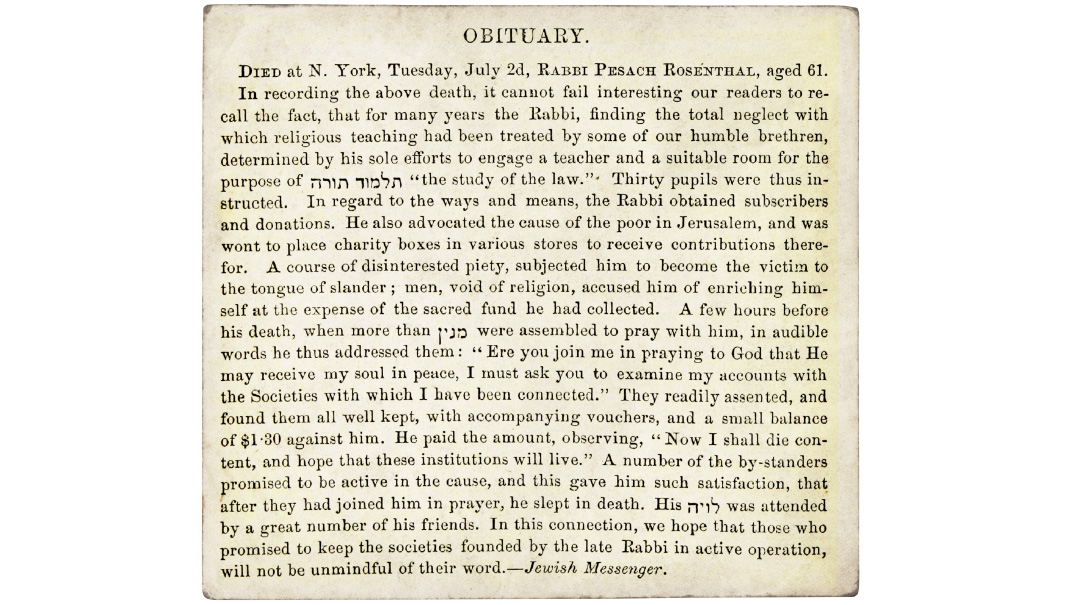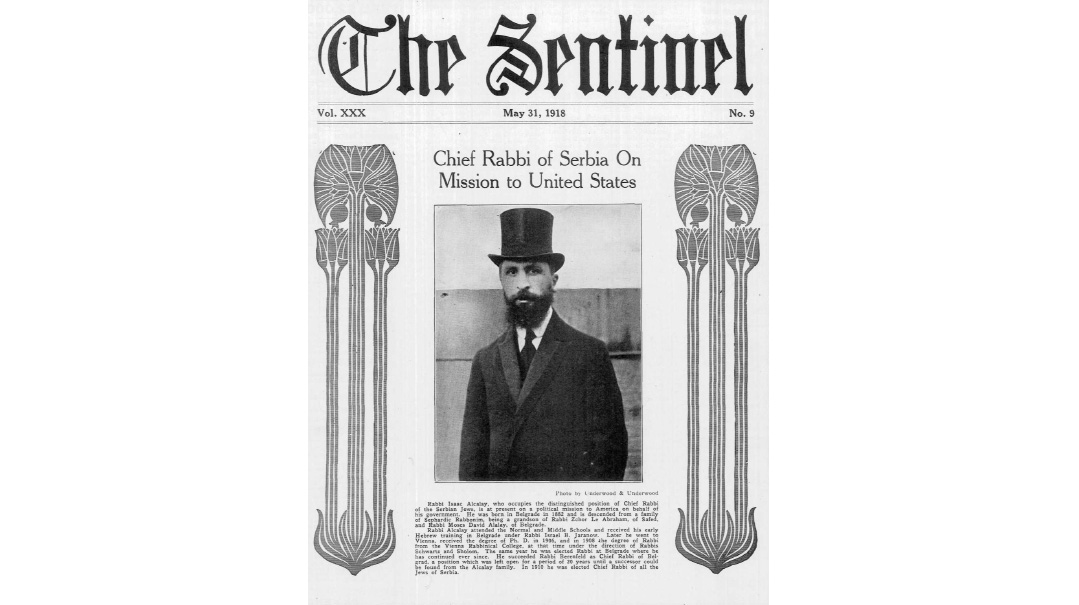The Torah Teacher’s Tragic Tarnish
| May 9, 2023In his gentle yet forceful way the honorable President Rosenthal stirred the hearts of our Jewish brethren to donate money to purchase a permanent home for the Talmud Torah

Title: The Torah Teacher’s Tragic Tarnish
Location: New York
Document: The Occident and American Jewish Advocate
Time: August 1861
Rabbi Pesach Rosenthal, a forgotten pioneer of 19th-century American Orthodoxy, immigrated from Poland in 1846. He served the Jewish community in Utica, New York, impressing Rabbi Isaac Leeser with his devotion during a visit in 1851.
Here, too, we met with a congregation having a place of worship, which, however, we regretted not finding in as good order as it should be. It is situated in Hotel Street, and is a wooden structure, and a little expense judiciously applied would render it as well-looking as the Beth-El at Albany. We hope that this will be speedily attended to. The minister is a learned Polish Rabbi, who wears the national costume. His name is Rabbi Pesach Rosenthal, and he officiates as Hazan, Preacher, and Shocket, and attends other duties besides. He is an illustration of the peculiar devotedness of the Jewish teacher to his calling, not rarely met within countries where the yoke of oppression weighs heavily upon us.
In Utica, Rabbi Rosenthal instituted an annual collection for the chalukah in the Land of Israel. He initiated that project following a fundraising visit by Rabbi Aaron Zelig Ashkenazi, a representative of Jerusalem’s Perushim community who passed through Utica en route to the Midwest in 1850. Rabbi Ashkenazi kept a detailed ledger of the donations he raised, and it lists the names 17 Jews in Utica who constributed, along with their greetings and notes in both Hebrew and Yiddish to friends in Palestine.
After about a decade in Utica, Rabbi Rosenthal moved to New York City, where Polish Jews were beginning to settle. He took the helm of Beth Hamedrash Hagadol, the first “Russian” Jewish congregation, which had been organized in 1852 on the Lower East Side in a “garret” of 83 Bayard Street. Judah David Eisenstein, who arrived in 1872, recalled that in the shul’s beis medrash one could “find Jews engaged in study.... It has many books, as in the great House of Study in Poland.”
Rabbi Rosenthal opened America’s first Talmud Torah in 1857, in the basement of Beth Hamedrash Hagadol. Yiddish served as the language of instruction, and the curriculum was modeled after the chadarim back in Poland.
In 1861, on the eve of America’s Civil War, Rabbi Avraham Zelig Ashkenazi’s successor, Rabbi Avraham Nissan, visited New York en route to California to obtain funds from Jews who benefited from the Gold Rush. Rabbi Rosenthal collected funds at Beth Medrash Hagadol and arranged for collections in area shuls. Nefarious rumors circulated that Rabbi Rosenthal had misappropriated some of these funds, leading to a dramatic scene that played out a few months later as he lay on his death bed.
Entirely Exonerated
Following Rabbi Rosenthal’s passing, various Jewish newspapers ran articles proclaiming his innocence and expressing regret for the way he’d been treated. Following his death, his son, Isidor Rosenthal, took over responsibility for the Talmud Torah, resolving to expand it further in his memory. An 1887 report from the directors and leaders of the Machzike Talmud Torah Society reads as follows:
In his gentle yet forceful way the honorable President Rosenthal stirred the hearts of our Jewish brethren to donate money to purchase a permanent home for the Talmud Torah, for so long as it is required to move from place to place it can never endure. He was as good as his word, removing from his pocket a $100 donation. Taking their cue from his example, many raised their donations.
He then called other meetings, and ultimately succeeded in collecting a sum amounting to some $4,000. Still he refused to stop and rest, and sought constantly to do more and more. Finally he succeeded in purchasing for the Talmud Torah, at a price of $16,000, the mansion that stands on 227 East Broadway. But alas the amount collected was too small to cover the cost of the purchase, that is $8,000 down, and the rest to be paid after a certain set period. So our president again extended his hand, and provided a loan from his own pocket to make up the $8,000 down payment. A few months ago the purchase was signed and sealed. The deed is done.
We can now thank G-d Almighty Who has kept us, sustained us, and brought us to the point where we can establish a building in Israel out of which the light of Torah can flow to the poor of our nation. This redounds to the glory of our Orthodox brethren in America, for can there possibly be a greater mitsvah or holier obligation than the teaching of Torah?
The Baal Ha’otzros
Dr. Julius (Judah David) Eisenstein was a rare genius and one of the most prolific Jewish writers of the 20th century. Having immigrated to New York from Poland in 1872, he spent the rest of his long life writing tens of volumes of Otzros — encyclopedic compendiums — on a wide array of Torah and general topics. He wrote in Hebrew and Yiddish and contributed hundreds of articles to every major newspaper and journal in both languages over the course of many decades. Among many other projects, he was the first one to translate the US Constitution and Declaration of Independence into Yiddish.
In his capacity as vice president of Beth Medrash Hagadol, he was active in New York communal life from an early stage, including the ill-fated hiring of Rav Yaakov Yosef as chief rabbi toward the end of the century. He also served at the helm of Kollel America on behalf of the Old Yishuv, and visited the Holy Land on four occasions. He passed away at the age of 101 in 1956.
Research by Professor Salo Baron, S. Joshua Kohen, as well as our good friends from Moreshes Chachmei America, was utilized in the preparation of this article
(Originally featured in Mishpacha, Issue 960)
Oops! We could not locate your form.






